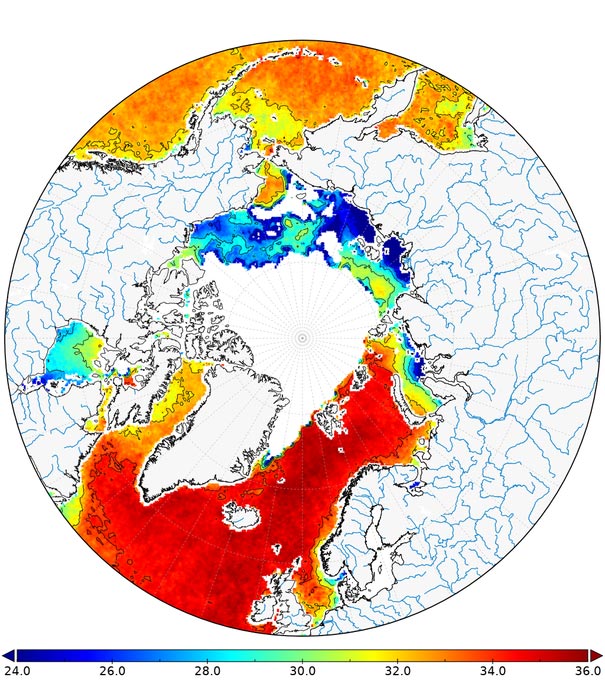Satellite-derived salinity improves Arctic marine circulation prediction

Arctic salinity map for the period from 11 to 19 August 2012
Credit: ICM-CSIC
This has been confirmed by researchers from the Institut de Ciències del Mar (ICM-CSIC) after producing sea salinity data obtained from measurements by the SMOS satellite, which were later incorporated into the TOPAZ Arctic prediction model.
Researchers at the Barcelona Expert Center (BEC) of the Institut de Ciències del Mar (ICM-CSIC) have proved that satellite-derived salinity improves marine circulation prediction in the Arctic, which, as in the rest of the planet, is directly influenced by this and other parameters such as temperature.
The scientific team has incorporated sea salinity data obtained from measurements by the European Space Agency (ESA) SMOS satellite into the TOPAZ Arctic prediction model, which assimilates in situ data and is used by the Arctic Monitoring and Forecasting Centre (ARC-MFC), distributed by Copernicus. This service generates near real-time forecasts of physical ocean and sea ice conditions, among other products.
“The assimilation of the sea surface salinity maps has had a strong impact on the model, with documented improvements in the Nordic Seas, the Greenland Seas and the Beaufort Sea,” explain the BEC and TOPAZ managers, who are confident that they will be able to update the model’s time series if the SMOS mission continues.
Salinity, a determining factor in the ocean
Seawater salinity is a parameter that depends on precipitation, evaporation, river discharges and ice melt, and has a direct effect on the climate. Together with temperature, it determines the density of the water which, in turn, drives global ocean circulation and regulates the Earth’s climate. However, measuring it in situ is not easy, especially in areas as remote and difficult to access as the Arctic Ocean, which is why the information provided by satellites is so valuable.
“Normally, sea salinity is measured in situ with conductivity, temperature and depth sensors, better known as CTDs. These allow salinity to be obtained over a wide range of depths, but only at specific points and times. Satellites, on the other hand, collect data constantly, whatever the environmental conditions, and even in the most remote areas. Specifically, we measure salinity using passive microwave remote sensing, which captures the electromagnetic energy emitted by surfaces and which, in the case of the ocean, depends on temperature and salinity,” explains Justino Martinez, researcher at the ICM-CSIC.
More accurate and reliable data
“The importance of having reliable and accurate data on sea salinity lies in the fact that it influences the density of the sea, thus affecting ocean circulation. It is also a fundamental indicator for the study of changes in freshwater flows that have been observed in some regions of the Arctic Ocean due to ice melting, which can influence the global climate”, points out the ICM-CSIC researcher Carolina Gabarró.
The details of the research, carried out thanks to data collected by SMOS, with which the ICM-CSIC has been working for many years, are included in a study recently published in the journal Earth System Science Data.
There, the authors highlight that the new version of the salinity product has a better spatial resolution and offers greater coverage of salinity than previous versions of the product. Thanks to this, it will be possible to study areas closer to the coast, as well as river mouths or areas of snowmelt.
The new version of the salinity product and the TOPAZ model, which has applications in the study of freshwater input, whether by melting sea ice and land ice, by river input, or by evaporation and precipitation processes, has been funded by the European Space Agency’s ARTIC+SSS project. The main objectives of this initiative were to develop new algorithms and methods for processing SMOS data to obtain an Arctic sea surface salinity product and to study the benefits of assimilating these data into circulation models.
“The improvement of satellite data, and consequently of circulation models, is extremely important, especially in the current climate crisis scenario, to understand the changes taking place in the Arctic and to improve future predictions,” conclude the researchers.
Reference Article
Martínez, J., Gabarró, C., Turiel, A., González-Gambau, V., Umbert, M., Hoareau, N., González-Haro, C., Olmedo, E., Arias, M., Catany, R., Bertino, L., Raj, R. P., Xie, J., Sabia, R., and Fernández, D.: Improved BEC SMOS Arctic Sea Surface Salinity product v3.1, Earth Syst. Sci. Data, 14, 307–323, https://doi.org/10.5194/essd-14-307-2022, 2022.
DOI: 10.5194/essd-14-307-2022
Method of Research: Computational simulation/modeling
Subject of Research: Not applicable
Article Title: Improved BEC SMOS Arctic Sea Surface Salinity product v3.1
Article Publication Date: 5-Oct-2021
All latest news from the category: Earth Sciences
Earth Sciences (also referred to as Geosciences), which deals with basic issues surrounding our planet, plays a vital role in the area of energy and raw materials supply.
Earth Sciences comprises subjects such as geology, geography, geological informatics, paleontology, mineralogy, petrography, crystallography, geophysics, geodesy, glaciology, cartography, photogrammetry, meteorology and seismology, early-warning systems, earthquake research and polar research.
Newest articles

Innovative 3D printed scaffolds offer new hope for bone healing
Researchers at the Institute for Bioengineering of Catalonia have developed novel 3D printed PLA-CaP scaffolds that promote blood vessel formation, ensuring better healing and regeneration of bone tissue. Bone is…

The surprising role of gut infection in Alzheimer’s disease
ASU- and Banner Alzheimer’s Institute-led study implicates link between a common virus and the disease, which travels from the gut to the brain and may be a target for antiviral…

Molecular gardening: New enzymes discovered for protein modification pruning
How deubiquitinases USP53 and USP54 cleave long polyubiquitin chains and how the former is linked to liver disease in children. Deubiquitinases (DUBs) are enzymes used by cells to trim protein…



